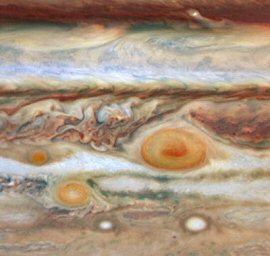
Astronomers from the University of California, Berkeley, say that the increased turbulence and storms first observed on Jupiter more than two years ago are still raging, prompting a theory that Jupiter is in the throes of a major climate change.
Examining the new images from the Hubble Space Telescope (the first since Jupiter emerged from its passage behind the Sun), UC Berkeley’s Imke de Pater said the upheaval was heralded in December 2005 by a color change from white to red of a large oval near the Great Red Spot, earning it the moniker Red Spot Jr. This oval, formally known as Oval BA, formed six years earlier through a merger of three large white ovals just south of the Great Red Spot – storms that formed in the early 1930s.
“One of the most notable changes we observe in the images is the change from a rather bland, quiescent band surrounding the Great Red Spot just over a year ago to one that is incredibly turbulent at both sides of the spot,” de Pater said. “During all previous observations and spacecraft encounters, starting with Voyager in 1979, such turbulence was seen only on the west or left side of the spot.”
Interestingly, a third red spot has appeared to the west of the Great Red Spot in the same latitude band. “Although much smaller in extent, the color is striking,” said UC Berkeley team member Michael Wong. “Like the other two large red storm systems, this newest red spot is bright in near-infrared wavelengths and dark in the ultraviolet. If this spot and the Great Red Spot continue on their courses, they will encounter each other in August, and the small oval will either be absorbed or repelled from the Great Red Spot.”
According to Philip S. Marcus, a professor of fluid dynamics at UC Berkeley, analysis of the images may support his 2004 conjecture that Jupiter is in the midst of global climate change that will alter temperatures by as much as 10 degrees Celsius, getting warmer near the equator and cooler near the south pole. He predicted that large changes would start in the southern hemisphere around 2006, causing the jet streams to become unstable and spawn new vortices.
“The appearance of the planet’s cloud system from just north of the equator down to 34 degrees south latitude keeps surprising us with changes and, in particular, with new cloud features that haven’t been previously observed,” Marcus said. “Whether or not Jupiter’s climate has changed due to a predicted warming, the cloud activity over the last two and a half years shows dramatically that something unusual has happened.”
Related:
New Red Spot Emerges On Jupiter
















![Jupiter 2 [from Lost in Space] - with Lights & Gantry Stand - Large picture](/store/img/g/kJsAAOSwb6Ffa-Qg/s-l225/Jupiter-2-from-Lost-in-Space-with-Lights-Gantry-St.jpg)

Comments are closed.